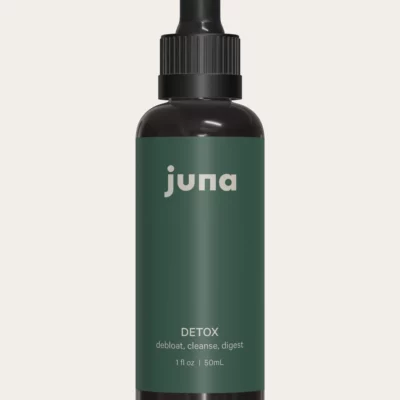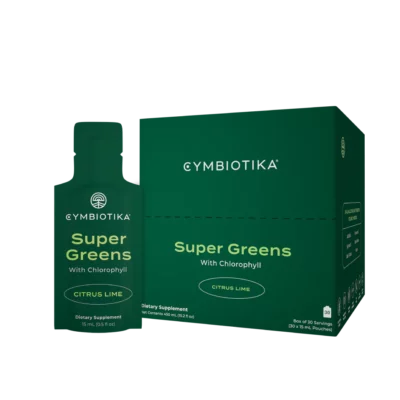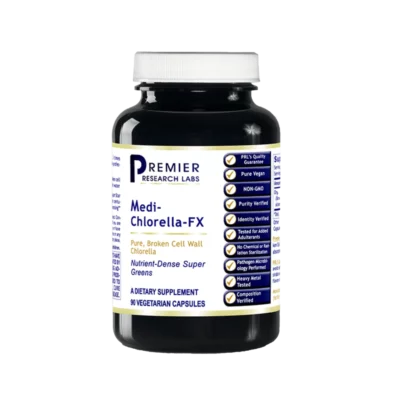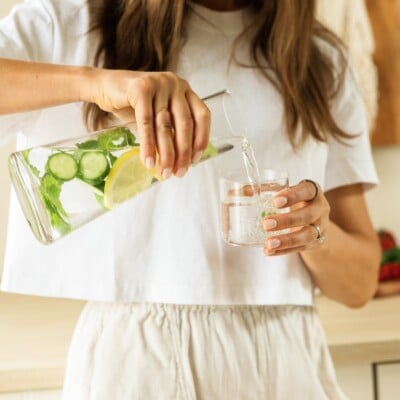We may receive a portion of sales if you purchase a product through a link in this article.
Like many others who lean on the wellness-y side of things, when it comes to feeling my best, I have my tried-and-true staples, my ride-or-die routines, and the healthy practices I’ll never dare skip. But when buzzy health trends *inevitably* catch my eye, I tread lightly and approach most anything in this realm with a whole lot of skepticism. So when I started to see influencers, celebrities, and just about everyone on social media chugging (re: mindfully sipping) glasses of water tinted a deep inky green, you can bet my interest was piqued. It was time to ask: what is chlorophyll water, anyways?
Well, ask an expert I did—and the questions didn’t stop there. What are the benefits? Any potential downsides or side effects? Is it really as simple as diluting and stirring into a glass of water? And, of course, where things really get heated: is chlorophyll water actually worth the hype? Craving a clear breakdown of the health trend that just won’t quit my social feeds, I tapped Integrative Nutrition Health Coach Georgia Perkins for guidance. Buckle up—your expert-backed answers await.
Featured image by Riley Reed.



Georgia Perkins is an Integrative Nutrition Health Coach and creator of Goodness With G, a wellness and lifestyle blog. Perkins takes a holistic approach to wellness in mind, body and spirit. She also offers a one-on-one coaching practice, in which she helps clients “transform their relationship with food and exercise, maintain realistic healthy habits and cultivate a fulfilled, balanced life.”
What is chlorophyll water?
A natural place to start. After pouring over the countless Reels, imagery, and videos that populate #chlorophyllwater on Instagram, it was clear that I was encountering something more complex than the verdant array of content initially made it seem. Turns out, my assumption was justified.
Upon further consideration, my thoughts drifted back to elementary school, remembering that chlorophyll was what gave plants their green color. From there, my mind goes blank (you’re reading the words of an English major, after all). Perkins rounds out my limited recollection: “Chlorophyll helps plants absorb energy and get their nutrients from sunlight in a process called photosynthesis. Chlorophyll is found in many green vegetables, particularly dark leafy greens.“
She continues, observing that chlorophyll water has risen to prominence in the wellness world because of its possible health benefits. Perkins notes that “while there are many possible benefits to consuming chlorophyll and chlorophyllin (a chemical made from chlorophyll), research is mixed and more studies are needed to confirm the potential health benefits.“
What are the benefits of drinking chlorophyll water?
Perkins first addresses this question with an important disclaimer. “If your intake of veggies like kale, collard greens, spinach, Swiss chard, and broccoli is already high, you likely don’t need to worry about taking a supplement. I always recommend starting with the real deal, as food in its pure form is often the most potent medicine.“
While there’s little scientific evidence to support the following benefits, many supplements claim that chlorophyll can:
- boost red blood cells
- aid in weight loss
- reduce inflammation
- detoxify the body
- prevent cancer
What is known? Chlorophyll is high in antioxidants, which Perkins notes, means that it can help protect your cells against oxidative stress. “These properties have been linked to potential cancer-fighting effects in humans, yet more studies are needed on chlorophyll specifically,” says the certified health coach.
In addition to that, and you may have heard this if you’ve also done a chlorophyll water deep-dive on TikTok, chlorophyllin has been seen to improve skin health. Perkins underscores these findings, citing studies conducted on patients with acne, enlarged pores, and sun damage. “Likewise,” she adds, “a few studies suggest chlorophyll may aid in alleviating body odor as well as wound healing.” Okay, I’m here for it.

Image by Michelle Nash
How do you prepare chlorophyll water?
Despite glasses and bottles of chlorophyll water showing up in abundance, there are alternative ways to reap the benefits. Perkins’ fave way to get her skin-supporting chlorophyll? “I personally enjoy adding it to my lemon water for a little extra flavor—and don’t worry, the color might be potent, but chlorophyll doesn’t have much taste at all! You can also add it to smoothies and juices as well if you prefer.”
When should you be taking chlorophyll water?
Good news: there isn’t a right or a wrong time to be sipping on your chlorophyll water. “I think it can make a great addition to a morning routine or whenever you’re feeling like your body could use an extra boost of nourishment,” Perkins says.


Is it possible to consume too much chlorophyll water?
Now for the (less than) fun part. While there are no significant risks of taking liquid chlorophyll, Perkins emphasizes that you should always pay attention to how your body responds to any supplement you introduce to your routine. “Some possible side effects include increased sensitivity to the sun, upset stomach, and discolored stools. Always consult your doctor if you are taking prescription medications to discuss potential interactions as well.“
Are there any dos and don’ts for incorporating chlorophyll water into your wellness routine?
When it comes to wellness, Perkins is in favor of keeping things as simple and accessible as possible. “It’s a misnomer that drinking chlorophyll water or a greens powder negates a poor diet.” What she favors instead? “I DO recommend that anyone and everyone increase their intake of greens! I always encourage a ‘food first’ approach and let supplements help fill in the gaps.”
In addition to keeping things streamlined, Perkins emphasizes that whatever you bring into your wellness routine is entirely up to you. Adding chlorophyll water to the mix is a personal choice, and it’s one that should be supported by a healthy dose of research and discussions with your healthcare provider. Perkins’ final word on the matter? “Chlorophyll water can certainly be a wonderful addition if it serves you and makes you feel good.”


Ready to start supplementing with chlorophyll? Perkins shares her recommendations.
From Perkins: “When purchasing a chlorophyll supplement (or any supplement), choose a brand you can trust based on the quality and purity of their products, good manufacturing practices and testing.”
Juna Detox Drops
Our team’s favorite detox supplement on the market, Juna’s detox drops contain potent antioxidants to fight oxidative stress and cell damage and promote healthy aging. Alongside chlorophyll, each dropperful contains lemon and mint, supporting digestive health and a flavor you’ll crave. Use code CamilleStyles15 to save on your new healthy habit.
NOW Foods Liquid Chlorophyll
Reap the detoxification benefits with a liquid chlorophyll that can be taken a teaspoon at a time in either water or juice. Bonus: the natural mint flavor keeps breath fresh.
Cymbiotika Super Greens
Cymbiotika’s Super Greens contains a bioavailable complex of natural plant compounds including chlorophyll, glucoraphanin, and broccoli seed to strengthen immunity and support cellular detoxification.
Premier Research Labs Medi Chlorella FX
Well-priced, each bottle contains 90 capsules of detoxifying chlorella—zero additives included.









